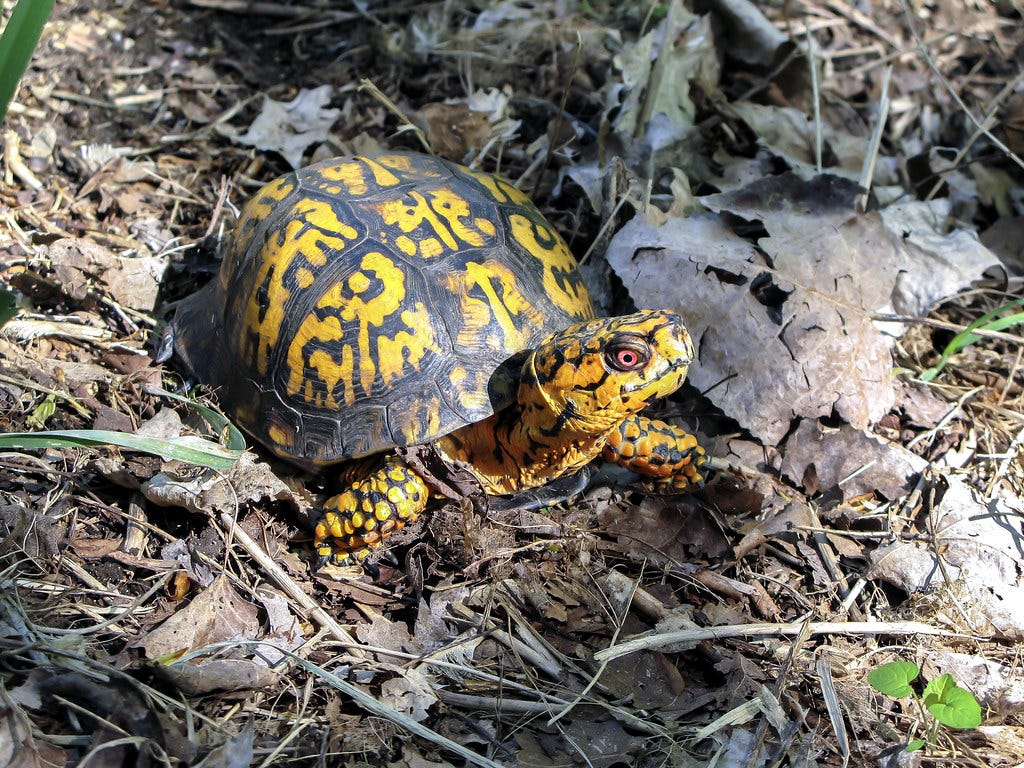Hello, Friends! It’s been a few minutes. But the dog days are over, and with them, my summer torpor is finally lifting.
Not a minute too soon, by the sounds of it. Some folks have apparently had a leaf or two drop in their yards, so now they're heading into battle with their mega-decibel blowers. (More on that scourge below.)
Let’s talk about those falling leaves. Did you know untold numbers of amphibians, reptiles, insects, birds and mammals depend on a layer of leaves to survive the colder months? With thanks to NWF Blog, here are a few examples:
Northwestern salamanders rely on the insulation and moisture leaves provide, and also the heat generated from their decomposition. As if being a blanket were not enough, the leaves also offer a banquet of tasty insects.

Eastern box turtles spend their brumation (reptile-ese for “hibernation”) two to six inches below the surface of the soil, which would get too chilly without a bedspread of leaves. Even when they’re not brumating, box turtles like to hang out among fallen leaves for the chic yet practical camouflage effect.

When temperatures hover around freezing, eastern red bats go into torpor (flying mammal-ese for “brumation”, or what The Bees’ Knees did this summer) on the ground. They wrap themselves in their furry tails and snuggle into a layer of leaves.

Female luna moths lay their eggs on the leaves of a tree, such as a white birch, walnut, hickory, or sumac. When the caterpillars hatch, they eat the host plant’s leaves. Once they’ve had their fill, they spin a cocoon. The cocoon later drops to the ground, which is hopefully springy due to a cushion of leaves. Sheltered and protected, it does its metamorphosis thing. It’s not just lunas. Something like 94 percent of moths drop from trees to pupate among leaves, soil and bark.

Mourning cloak butterflies take it a step further by spending even their adult winters in the leaves. On the occasional warm winter day, they can pop out for look-see, and since their commute’s so short (no migration!), they’re often the first to show up in the spring and last to disappear in the fall.

Ovenbirds build their nests right on the ground. The deeper the leaf layer, the more concealed and protected they are from predators. Like their salamander friends, ovenbirds also partake of the insect banquet provided by the leaves.

All but the queens in yellow-faced bumblebee colonies die off in the fall. The establishment of new colonies in the spring depends on the queens surviving the winter. They hibernate (apian-ese for “torpor”) a few inches underground, insulated by leaves. Where leaves are sparse or absent, few make it.
(A little added shoutout to bumble bees: they are in some cases six times more efficient at pollinating than honey bees. Go, bumbles!)

As the National Wildlife Federation puts it, “the leaf layer is not just nature’s refuse – it’s a lifeline for countless species.”
So, please: be a litterbug and leave the leaves. My strategy in recent years is to allow them to rest in peace under trees and in garden beds. I remove them from my (ever-diminishing) lawn and any walkways or patios, and just add those to the planted areas. Saves me labor, provides me with free, organic mulch and fertilizer, and does a world of good for our local critters. You can find more on this subject here.
While we’re on the topic. Washington, DC has banned the sale of gas-powered leaf blowers. Montgomery County, MD, where I live, is about to do the same. This is great news. Those machines would be ear-splitting, air-polluting menaces even if they weren’t destroying the fragile ecosystems created by fallen leaves. But wherever you are, you don’t have to wait for the politicians. You can just stop using them yourselves. You can even ask your landscaping crews to stop using them. There are battery- and electric-powered substitutes. Even better, there are rakes! You can find more on this theme here.
If you live in the DC vicinity and could use assistance with sustainable landscaping, visit Bees’ Knees Design. I’d be happy to help you.
Resources
Brailei Hardt, “Seven Species that Need You to Leave the Leaves,” NWF Blog, October 4, 2023. (Hat tip to Kathy Daniel for bringing this to my attention.)





What a fun, beautifully illustrated, blog, Lolly. ❤️
Rakes???! Love it. Thanks for another enlightening post!